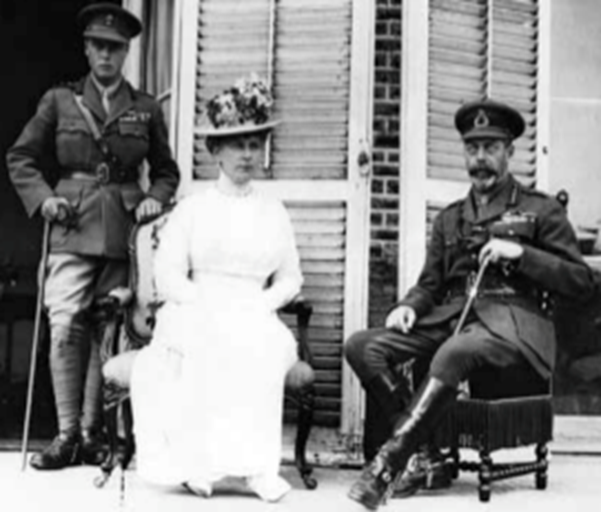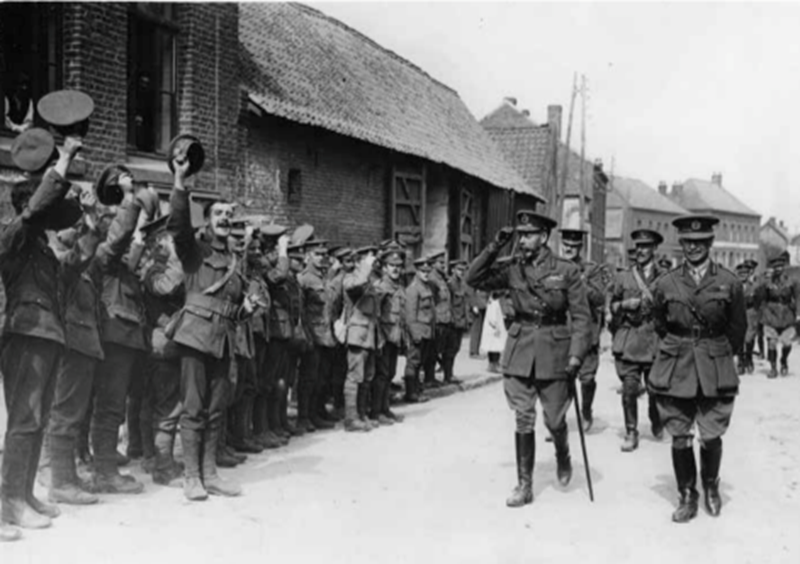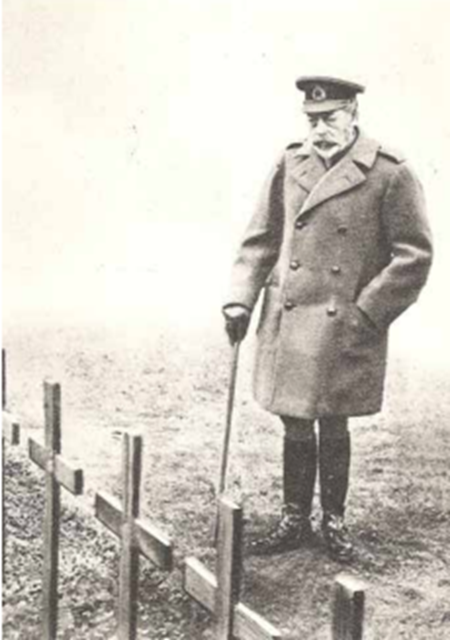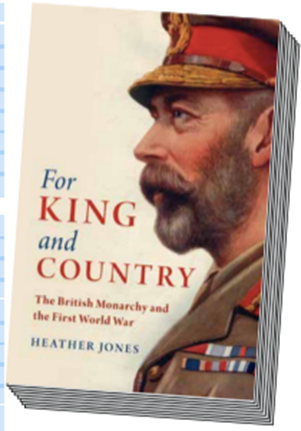The British Monarchy and the First World War by Professor Heather Jones
- Home
- World War I Articles
- The British Monarchy and the First World War by Professor Heather Jones
[This article first appeared in the July 2022 edition of Bulletin. No.122. Members receive seven magazines a year, four issues of our journal Stand To! and three issues of our member/branch magazine Bulletin.]
The First World War is often seen as a time when the British monarchy came under threat from a rise in revolutionary anti-monarchism. The reality is that this threat has been exaggerated. In fact, many older monarchist beliefs and values such as fulfilling one’s duty to the king also continued to exist during the war in ways that were important in shaping how British people understood the conflict.
Ultimately an examination of the evidence suggests that the monarchy remained relatively popular during, and after, the war and anti-monarchism in Britain had little support. Much of this was due to the policies adopted by King George V and Queen Mary who recognised the need for royalty to rapidly adapt and respond to the wartime climate but to do so in ways that often preserved older traditions of the monarchy providing religious leadership and serving the people. While the monarchy introduced important modern changes during the war, such as better media communications, these adaptations co-existed with promoting older ideas about the role of royals in setting a moral example in wartime.

During the First World War the British monarchy played a key role in the war effort. In the period from 1914-1916, before conscription was brought in, ideas about defending one’s ‘King and Country’ were central to recruitment campaigns, with the slogan appearing on posters, on postcards, at memorial services for the fallen and in speeches. In October 1915, the king issued an appeal in the press for volunteers in conjunction with the launch of the Derby Scheme.
The monarchy successfully associated itself with war patriotism in the first years of the war, to the extent that its close familial links with Germany – the King was a cousin of Kaiser Wilhelm II – as well as its German ancestral heritage were virtually entirely disregarded until 1917. That year, the King’s lead advisor, his private secretary Lord Stamfordham, panicked by the outbreak of the February Russian Revolution and the way that Russian revolutionaries had used the Tsarina Alexandra’s German birth to stir up the overthrow of the Tsar, deemed it wise to pre-emptively change the royal dynastic name to Windsor to ensure that no potential revolutionaries in Britain could ever similarly slander its royals about their German origins. The name change proved hugely popular.
The royal family were also used to promote home front cohesion, visiting innumerable war munitions factories, shipyards and mining areas during the war. These visits were designed so that they were seen by the maximum number of workers possible. The king and queen also reached out to the leaders of the Labour movement and even at times acted as intermediaries between them and the government. These actions enhanced the popularity of the monarchy. Indeed in 1917 the king and queen were sent by the cabinet to visit striking areas, which were angry with the government, where the king met with some of the workers’ leaders. This highlighted the extent to which the monarchy remained popular in these areas. The efforts the royals made to integrate Labour during the war were prescient and helped to ensure that British Labour remained dominated by reformists who sought to win power at Westminster rather than through the kinds of violent revolutions that would occur elsewhere on the continent during the war.
The monarchy also introduced new honours during the war aimed at extending the honours system to reach more ordinary people. The 1916 Military Medal was intended to honour bravery by other rank soldiers while the 1917 introduction of the Order of the British Empire (OBE) allowed the monarchy to recognise ordinary civilian war workers, including women. These proved very popular gestures, and involved the royals meeting ordinary people at investitures, further increasing the number of encounters between the royals and the general public, helping to develop what historian Frank Mort has described as the ‘accessible’ monarchy.
The king was also very focused on promoting the welfare of the troops and made six visits to the Western Front during the war to boost morale and to see for himself how those whom he saw as ‘his’ soldiers were being treated. Beyond Britain, the monarchy was also a key war symbol used to mobilise the empire and there is evidence of how Indian troops were encouraged to understand the war in terms of fighting for the ‘King- Emperor’.
Famously, all those serving in the war received a gift-box from Princess Mary as a result of her fundraising campaign to send a Christmas gift to each individual soldier and sailor in 1914; the scheme was later extended to include nurses. The king also visited Scotland during the war after the battle of Jutland to review the damage done to the fleet and honour those who had fought. His own son, the future King George VI, was at Jutland and took part in the battle.
King George V’s heir, the future Edward VIII, lobbied to be sent to the Western Front, arriving in late 1914. Although a staff officer, he deliberately went to the forward areas and came under
shellfire on many occasions. Edward’s personal efforts to see for himself how the troops in the trenches and dugouts were doing helped to make him extremely popular with soldiers. He took real risks, partly because he felt humiliated that as heir to the throne he had been prohibited from fighting in combat himself. He also became profoundly cynical and anti-war by 1918 – the roots of his later appeasement of fascism were sown in his war experiences on the Western Front.
The monarchy reacted to wartime by making major changes to its projection of wealth and power. The king and queen stopped attending entertainments such as horse racing or the theatre for the duration of the war. The king famously stopped drinking alcohol for the duration of the conflict too, something he did in the hope that it would inspire the rest of the population to do likewise. He was disappointed to find that while his gesture was appreciated and boosted the popularity of the monarchy, it did not trigger a mass wartime temperance movement. The queen rigorously implemented strictly reduced menus at the royal palaces serving only the plainest of fare, with meat only allowed three times a week; this at a court where pre-war meals had run to thirteen courses. These gestures were deliberately introduced as a way to show the royals’ solidarity with thesuffering of the British population at war.
It was a suffering that the king and queen saw first-hand. They both regularly visited hospitals, often accompanied by their daughter, the teenage Princess Mary. Accounts of royal hospital visits make clear that the king and queen spent time speaking with the wounded – these were not merely perfunctory inspections but real moments of engagement with war patients. They also visited hospitalised shell-shocked officers and institutions working to rehabilitate the war disabled.
When London was bombed in a Gotha airplane raid in June 1917 the king visited the site of the bombing within hours and then went on to see the wounded in hospital. On occasion, the king even watched wartime surgical operations. This kind of display of immediate concern and solidarity with the victims of war was key to sustaining the monarchy’s wartime popularity and also ensured that the king and queen remained extremely well-informed as to the realities on the ground for wartime civilians in Britain and soldiers at the front.
However, this came at a cost: the king confided after the war ended that ‘you can’t conceive what I suffered going round those hospitals during the war.’ On many occasions, the king and queen encountered young men dying of war wounds during these visits. With their own two eldest sons serving, it is not hard to realise how difficult such encounters must have been. Added to this was the burden of belief that these young men were dying for their ‘King and Country’, which meant that the royals felt a terrible responsibility to live up to their sacrifice.
Religious ideas underpinned this. The king’s wartime statements regularly invoked God’s blessing upon the British people and the monarchy’s role in the war had a clear spiritual dimension, particularly in its close association with wartime National Days of Prayer, a tradition revived during the conflict of calling the people to prayer for deliverance of the country from peril. These National Prayer Days, spearheaded by the Church of England but multi-denominational in nature, were very well-attended in 1914-1918. Both King George V and Queen Mary were personally religious and saw their role as one of setting a moral example and spiritual leadership. The idea that self-sacrifice was noble and Godly was one that they both truly believed in.

Ultimately, the success of the British monarchy in sustaining its wartime popularity becomes clear by comparing the island of Britain to what was occurring elsewhere. The Hohenzollern monarchy in Germany saw its popularity plummet long before the German defeat due to the crass insensitivity of the Crown Prince Wilhelm who held a command role at Verdun. Blamed for his military errors and also hated for spending most of the war entertaining in luxury accommodation far from the dangers of the front and the sufferings of his men, the Crown Prince helped fatally undermine the German monarchy, a process capped by his decision to build an expensive new 170-room palace, the Cecilienhof at Potsdam during the last years of the war when German civilians were suffering severe food shortages due to the Allied blockade.
The Kaiser’s court in general also conceded little to wartime conditions. Queen Mary and Princess Mary regularly turned up to work in munitions factory canteens or to hand out food in bombed areas of London or to returning troops, intimate gestures that contrasted with the continuation of strict pre-war court hierarchies towards ordinary people in Germany and Austria-Hungary.
In Ireland, which during the war was part of the United Kingdom, the rise of republicanism following the 1916 Easter Rising was swift and offers an important contrast with Britain. Royal symbols and statues were vandalised; newsreel of the royals was booed in cinemas. There was a concerted campaign of anti-monarchism and widespread public debate about what sovereignty meant in a republican system, which ultimately led to the Irish War of Independence in pursuit of an independent Irish republican state.

In contrast, in Britain, the Prince of Wales could travel to the opening of parliament in 1918 without an escort, highlighting that the security situation for the royals had not deteriorated due to the war. In the immediate aftermath of the Armistice, the king and queen toured working class areas of London in an open carriage to the acclaim of huge crowds. This again highlights that the popularity of the British monarchy remained largely intact during and after the conflict, despite the fears of palace courtiers, triggered by anti-monarchist revolutions in Russia and across Eastern and Central Europe.
In the wake of the war, the British monarchy took the lead role in commemorating the war dead. King George V unveiled the cenotaph and acted as chief mourner at the burial of the Unknown Soldier in Westminster Abbey, ceremonies which drew enormous crowds. The fact that it was considered appropriate that the monarch be at the centre of these events again indicates the popularity of the monarchy. Indeed, across Britain many local war memorial committees chose the wording ‘for King and Country’ to put on the war memorials that they fundraised for and designed. This shows that this was not an empty slogan but a profound and widespread understanding of the role of the royal family in the war and a mark of their continued status.
War commemoration even gave the British monarchy a new sacred role as the interwar era of greater democracy dawned in Britain with the 1918 extension of the franchise. Through war commemoration the monarchy could continue to symbolically incarnate the British people and preserve its ceremonial aura of mystery at the annual remembrance ceremony at the Cenotaph. Ultimately, the British monarchy was able to successfully blend modernising with older monarchist values during the First World War in ways that ensured that it remained popular.





